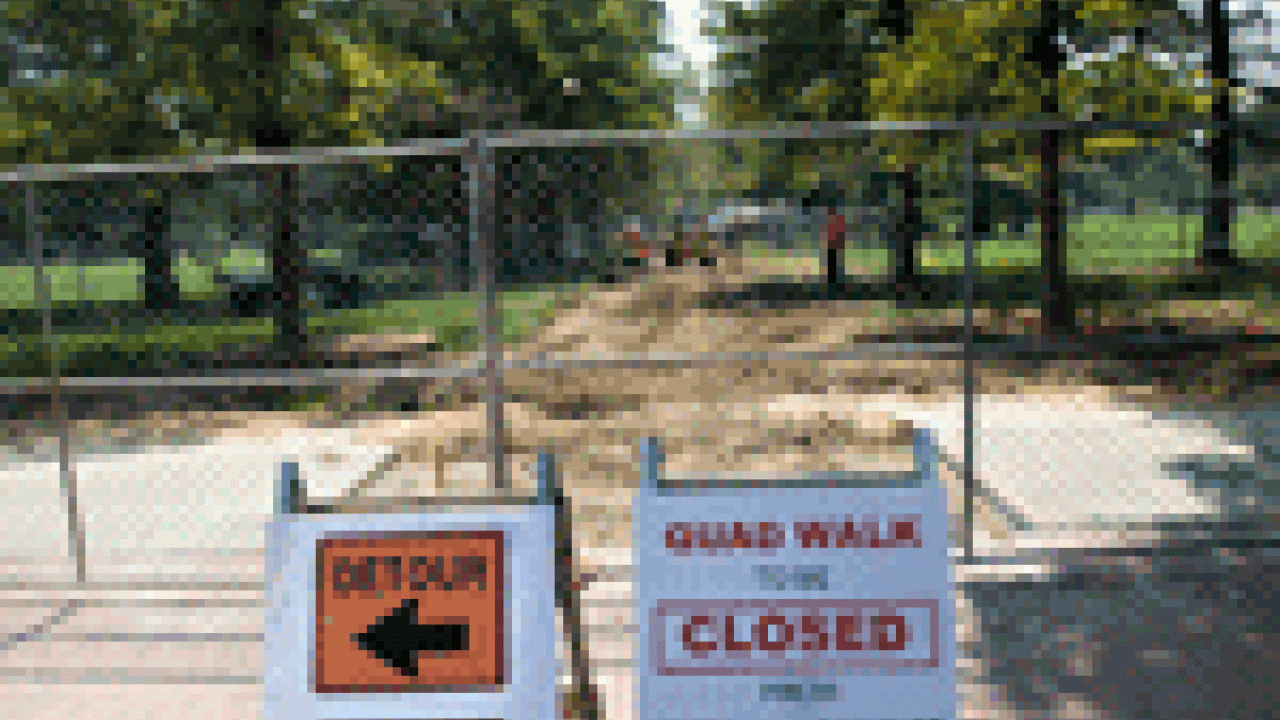Centennial Walk is under construction on the Quad along the same path that students, faculty and staff have been walking for nearly 100 years.
Inside the fenced-off construction zone, a contractor's crew ripped out the old walk on July 23. The new walk's unveiling is set for Oct. 15, during the university's Centennial Fall Festival, commemorating the 1908-09 term when students first lived on campus.
Planners said the new walk will be twice the width, at 12 feet, but other than that will not be drastically different than the old. "We wanted to respect the past," said Skip Mezger, the campus's senior landscape architect.
"We didn't want to change a lot from what was there, but we certainly wanted to upgrade it for the centennial," he said.
The 450-foot-long walkway will still be concrete, but 1-foot-wide granite paving stones will be added to the edges. Also, the project will bring back a circle feature at the Quad's center, in the middle of the walkway.
Assistant Vice Chancellor Bob Segar has a dual interest in the walkway, as campus planner and the leader of the centennial planning team. "We see the walkway as a path through history, and we are proud to be able to refurbish it to start UC Davis' second century," he said.
The path dates back to around 1915 and some of the University Farm's earliest buildings: the West Hall dormitory (where the Memorial Union sits today) and a classroom building (site of Shields Library). A straight, dirt path connected the two.
By the early 1930s, the path had been converted to concrete and the adjacent fields had been equipped with pipes and sprinklers for irrigation. Turf and trees followed, turning the 5.5-acre site into the Quad.
Early maps and photos show the walkway going through a circle defined by a hedge, with benches on the inside and trees on the outside -- trees that are still there today. The circle sat on slightly raised ground, a difference in elevation that still exists but is hardly noticeable.
The hedge and benches had been removed by the 1950s, Mezger said, though he does not know why. For history's sake, he and his team decided to bring back the circle, at the same raised elevation, but without the hedge and benches.
It will be 54 feet in diameter, with a circular slab of concrete in the middle, a ring of grass around the concrete, and a ring of granite pavers around the grass.
"We're trying to emphasize the center of the Quad as a place where you could gather to meet people, or listen to speakers," Mezger said.
Christina DeMartini Reyes, assistant landscape architect, showed a sample of Sierra granite that will add a California touch to the middle of the concrete circle at the center of the Quad.
"We're calling attention to the center of the center of campus," she said.
It is indeed the social heart of campus, a place for eating lunch and reading books, for talking with friends, for taking naps, for Frisbees and festivals. Reyes and Mezger do not see that changing at all.
"The Quad will still be the casual place it is today, and the place our students remember," Mezger said.
The only real stylish upgrades are brass expansion joints along the walkway and brass-letter inscriptions on rectangular Sierra granite slabs at both ends of the walkway. The inscriptions will read: "Centennial Walk, Dedicated October 15, 2008."
Functional upgrades include 92-foot-diameter semicircles at the ends of the walkway, providing a transition area for people entering the walkway from the right and left, or exiting the walkway.
The project's cost is estimated at $350,000, with the money coming from the campus's Road and Path Improvement Fund.
The same fund is paying for $500,000 worth of improvements between the Silo and the new Giedt Hall. The project, still under way, features a new sidewalk roughly parallel to an existing bike path -- thereby separating pedestrians and bicyclists on what has become a busy corridor since Giedt Hall's opening in 2007.
Media Resources
Clifton B. Parker, Dateline, (530) 752-1932, cparker@ucdavis.edu
